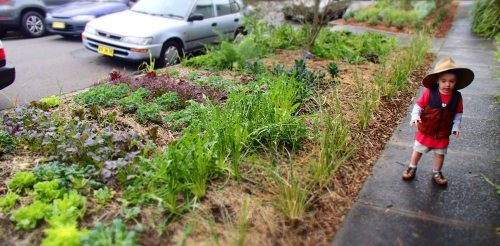Article by Cheryl McKenna – Office Manager, and licensed estate agent.
Ahhh, there is nothing better than mowing your back lawn, then your front lawn, then having to get the mower through the front gate and mow the nature strip – said no person ever! Especially if you are lucky to live on a corner block with that soft, cushiony grass that my mower gets bogged on EVERY TIME then leaves big bald patches…I’m sure that it enhances the street appeal!
But seriously, what a wasted space! As our cities grow, our house blocks get smaller and our lives become busier we need to garden smarter, not harder. Nature strips are a necessary evil – we don’t own them, so can’t park on them, but we have to maintain them, so let’s capitalise on this ‘bonus space’ by planting on them.
With growing awareness around where our food comes from, biodiversity and sustainability, people are becoming more committed to sourcing local produce to reduce environmental impacts, to know where their food is coming from and how it has been treated, and also in ensuring that local native plant and insect species continue to thrive.
Warrnambool 2040 is a community plan developed through an extensive community-led process, capturing the community’s aspirations for the future of Warrnambool. A number of goals from the plan focus on our environment, specifically listing the aim, by 2040, to have over 50% of fresh produce being sourced locally, from backyards, community gardens, farmers markets and local businesses. In a closer timeframe of 2026 the aim is to have Neighbourhood Food Assets increase, with vegetable patch nature strips supported. Check out the link for the full plan Our Plan – Our Future W2040
Not all of us have the space in our back or front yards to allocate to a vegetable garden, but many of us have a nature strip. Similarly, not all of us have the time to maintain a vegetable garden, but there are a vast number of local native plants that require little to no maintenance at all, and will grow to become an attractive, ‘no-mow’ space that will attract native bees, butterflies and other beneficial little creatures to our local area.
A few considerations to bear in mind when considering your nature strip planting –
- Soil may be contaminated – A soil test is a good start, especially if you are planning on planting edibles.
- Produce might be taken – the nature strip, at the end of the day, is public land. If you plan to grow edibles, grow them with the view of making it a ‘share garden’. What an amazing place our town would be if we planted with the focus to share our ‘riches’ with others, or to create an environment of swapping produce!
- Find out what lies beneath – service assets often run underneath nature strips, so if these need to be accessed your planting may be disturbed.
- Know what you are planting – some native plants that are beautiful elsewhere may be a noxious weed in this area. Check out the Australian Plant Society Warrnambool website for a list of plants native to our beautiful area, or this Plant Selector Tool on the WCC website.
- Safety First! Planting close to a road can be dangerous, so be sure to take care!
The Warrnambool City Council have had great foresight in developing, with community consultation, Nature Strip Landscaping Guidelines for residents to follow when planting their nature strip. A permit is required, but the guidelines give great information about what is required.
So, have a crack! Talk to your neighbours, make it a collaborative approach! Help to make Warrnambool to reach its goals of sustainability, biodiversity, and I say now “you’re welcome” for giving you your weekend nature strip mowing time back!
We would love to see photos of local nature strip planting – show us what you have done and inspire others to do the same.

